Our history
Our history
Our history
Historical notes
From the early 30s of the twentieth century, in the immediate vicinity of Venice, a hand weaving business came to life on the initiative of a young woman with uncommon entrepreneurial energy, Gegia Bronzini. First as a weaving school and immediately after as a production workshop, the business grew and took on its own creative identity. The exhibitions started with the show at the Loggetta Sansovino, Venice 1936, followed by the opening of the first store in Venice, then in Milan in 1939 and finally in Cortina d'Ampezzo. The production activity focused on furnishing fabrics, evidenced by numerous quotations in the most prestigious magazines in the sector, participating also from the '50s at the Triennial of Milan before and at the Selettive del Mobile later. But there was no lack of experiences related to clothing fabrics, with the creation of dresses presented in catwalk shows in the setting of the Cortina store. At the end of the 40s the company moved to Cantù, where it received the stimuli of the booming furniture sector. The following decades were full of satisfactions, of important and lasting collaborations until 1976, the year of Gegia's death, with the transition to her daughter Marisa who became a reference figure for her outstanding artistic skills and remarkable creative sensibility. In 1982 the workshop moved to Carimate, near the castle, in a historic building whose spaces enhanced, as if by contrast, the modernity and rigor of the textile productions that for the next twenty-five years would be created and realized to complete exclusive interior design projects. The activity did not stop even with the passing of Marisa, in 2007, transforming and reinventing itself continuously. Now it continues on the same hand looms, respecting the original creative principle, flanked by the Tessile Officina with which it shares space and skilled workers.
Historical notes
From the early 30s of the twentieth century, in the immediate vicinity of Venice, a hand weaving business came to life on the initiative of a young woman with uncommon entrepreneurial energy, Gegia Bronzini. First as a weaving school and immediately after as a production workshop, the business grew and took on its own creative identity. The exhibitions started with the show at the Loggetta Sansovino, Venice 1936, followed by the opening of the first store in Venice, then in Milan in 1939 and finally in Cortina d'Ampezzo. The production activity focused on furnishing fabrics, evidenced by numerous quotations in the most prestigious magazines in the sector, participating also from the '50s at the Triennial of Milan before and at the Selettive del Mobile later. But there was no lack of experiences related to clothing fabrics, with the creation of dresses presented in catwalk shows in the setting of the Cortina store. At the end of the 40s the company moved to Cantù, where it received the stimuli of the booming furniture sector. The following decades were full of satisfactions, of important and lasting collaborations until 1976, the year of Gegia's death, with the transition to her daughter Marisa who became a reference figure for her outstanding artistic skills and remarkable creative sensibility. In 1982 the workshop moved to Carimate, near the castle, in a historic building whose spaces enhanced, as if by contrast, the modernity and rigor of the textile productions that for the next twenty-five years would be created and realized to complete exclusive interior design projects. The activity did not stop even with the passing of Marisa, in 2007, transforming and reinventing itself continuously. Now it continues on the same hand looms, respecting the original creative principle, flanked by the Tessile Officina with which it shares space and skilled workers.

1950 - Ceramics and fabrics, Domus n. 252/53, November-December 1950
1950 - Ceramics and fabrics, Domus n. 252/53, November-December 1950
1950 - Ceramics and fabrics,
Domus n. 252/53, November-December 1950
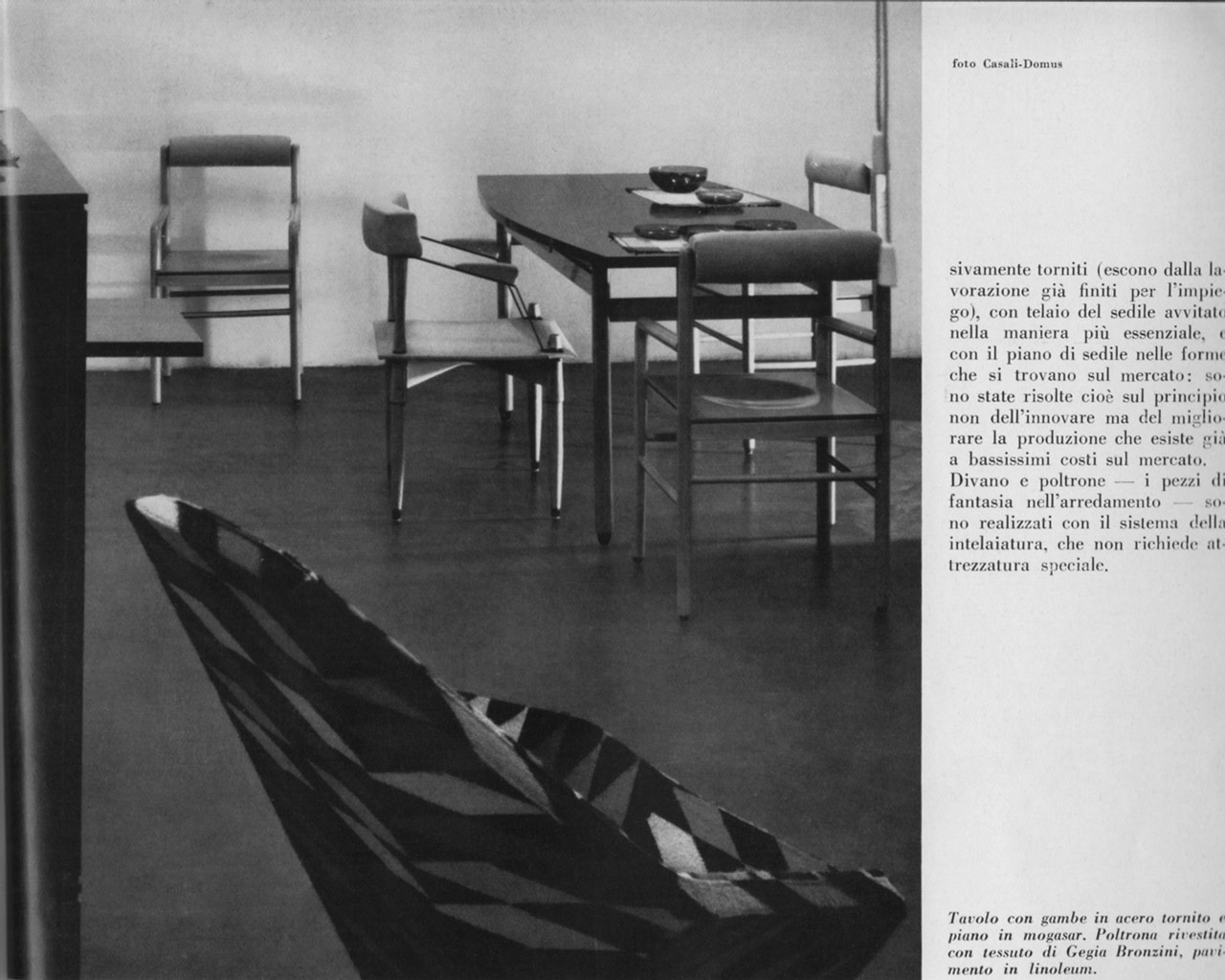
Table with legs in turned maple and mogasar top. Armchair covered with Gegia Bronzini fabric, linoleum floor. Domus n. 301, December 1954.
Table with legs in turned maple and mogasar top. Armchair covered with Gegia Bronzini fabric, linoleum floor. Domus n. 301, December 1954.
Table with legs in turned maple and mogasar top. Armchair covered with Gegia Bronzini fabric, linoleum floor. Domus n. 301, December 1954.
Tradition and color in the art of Gegia Bronzini
Tradition and color in the art of Gegia Bronzini
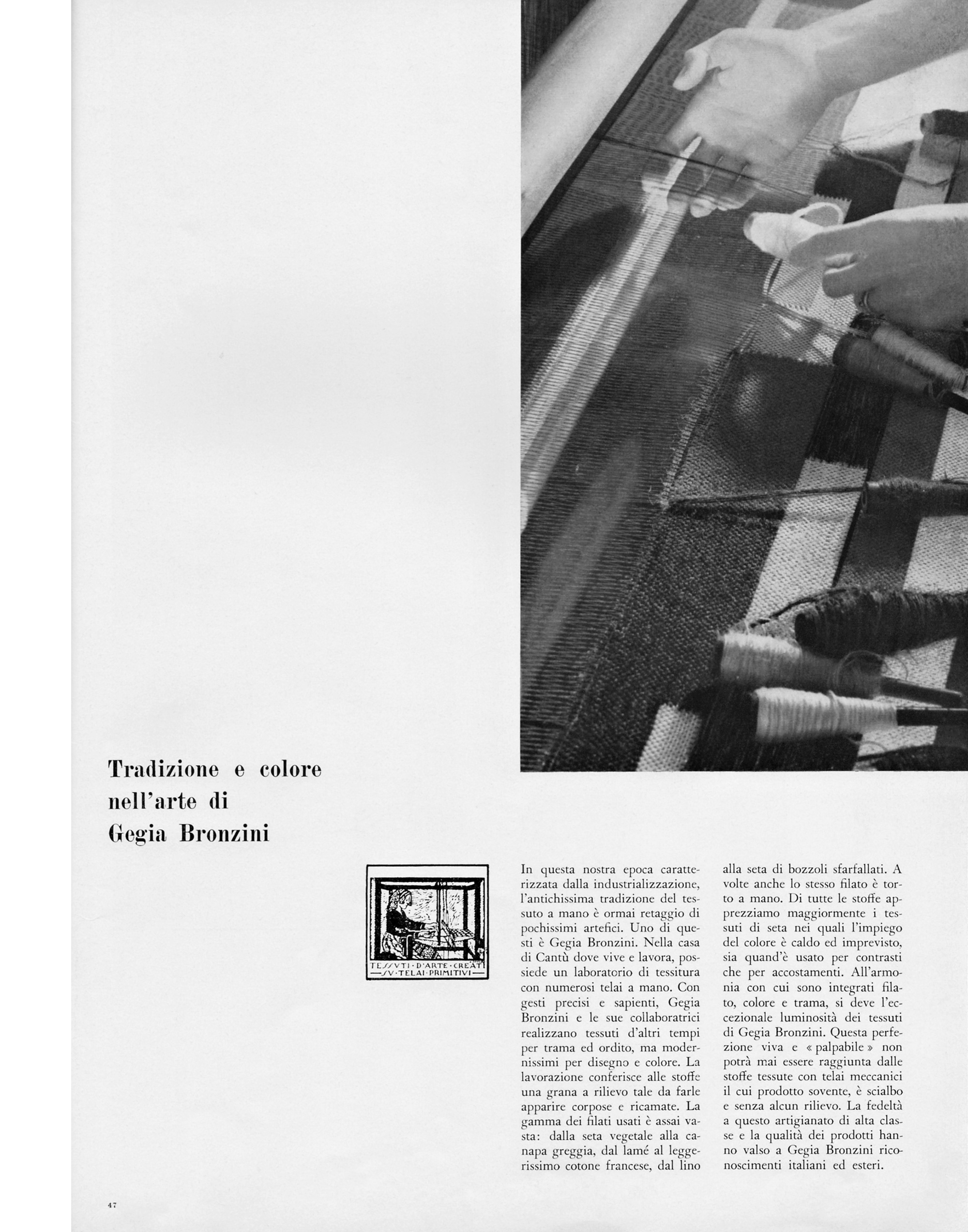
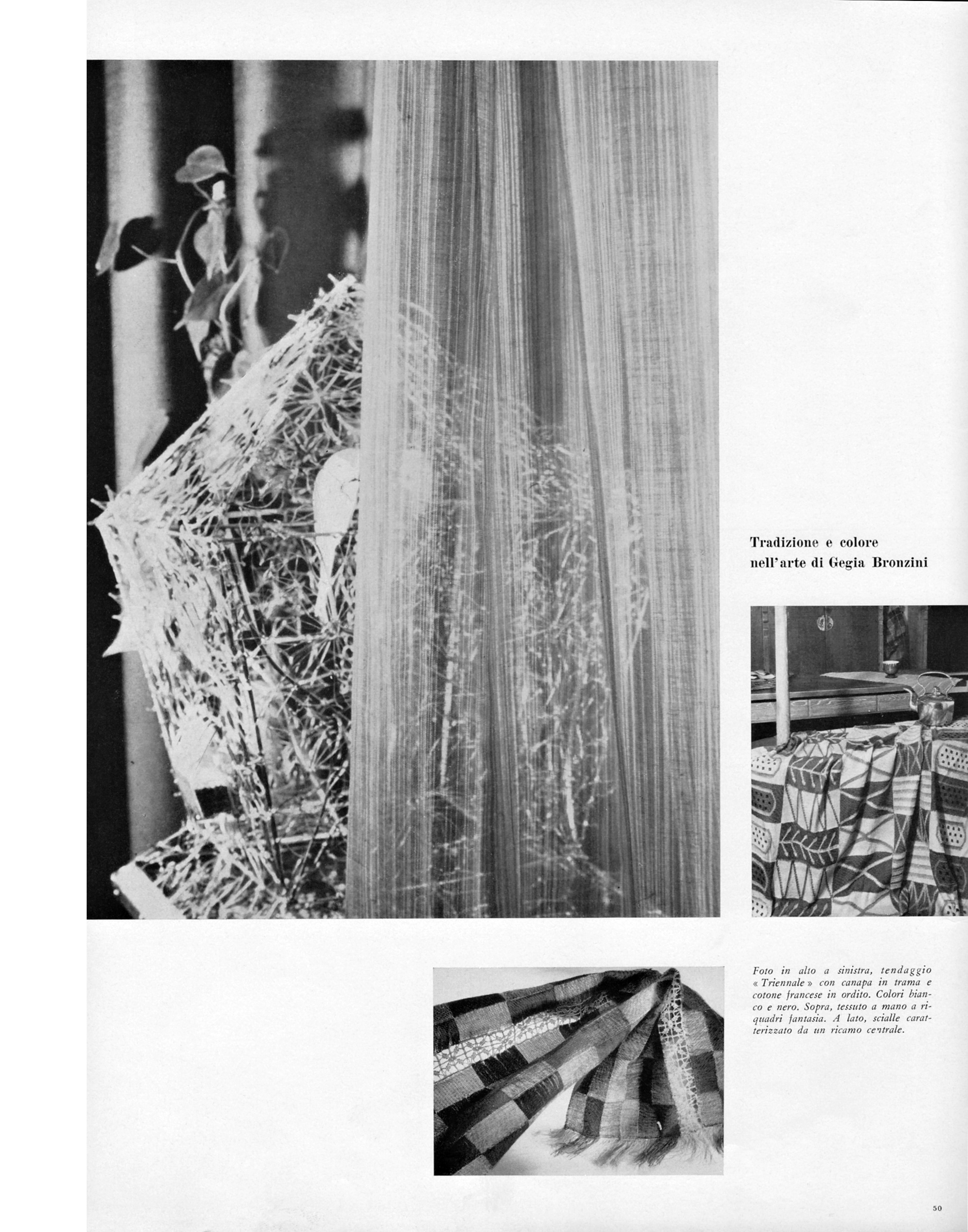
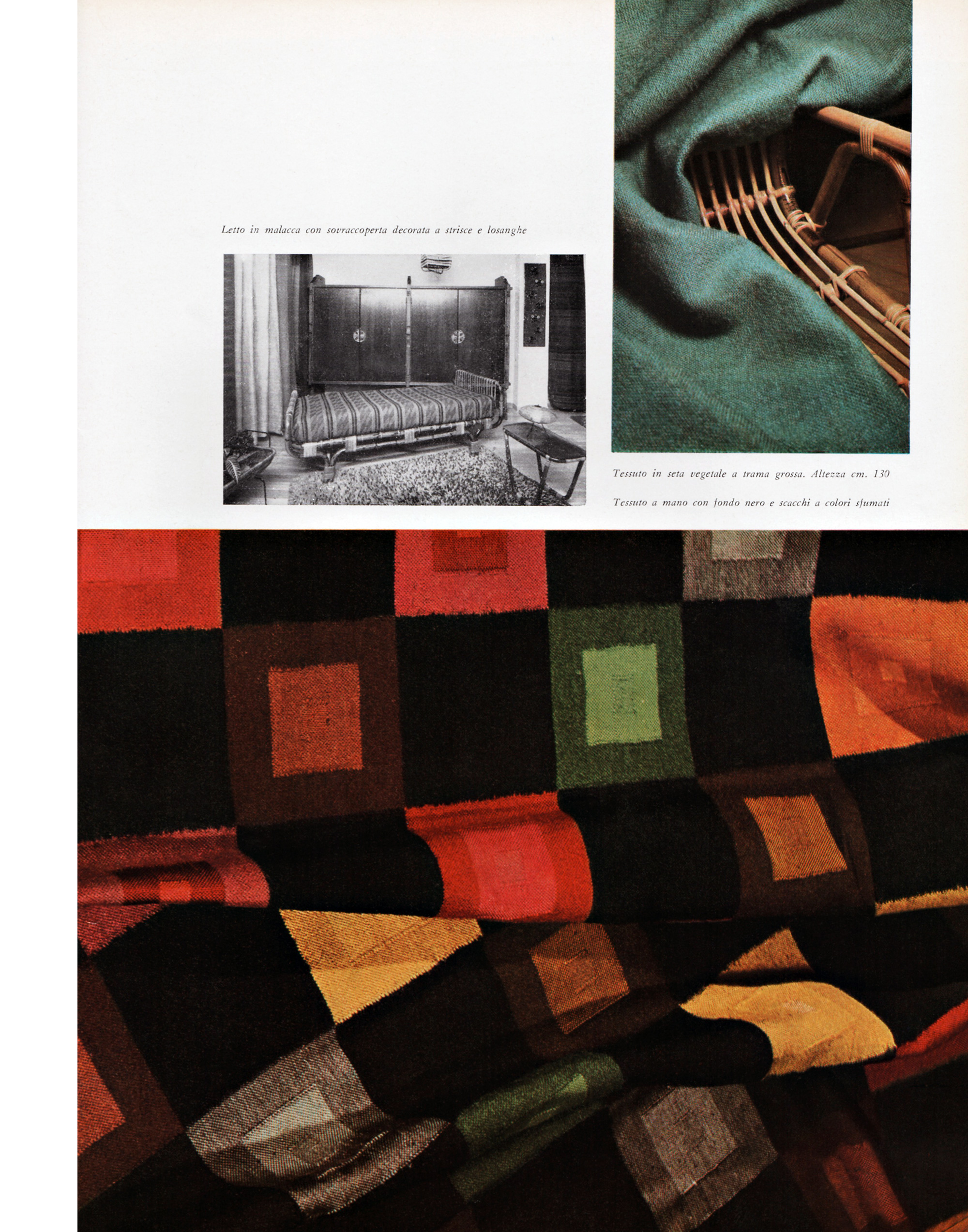
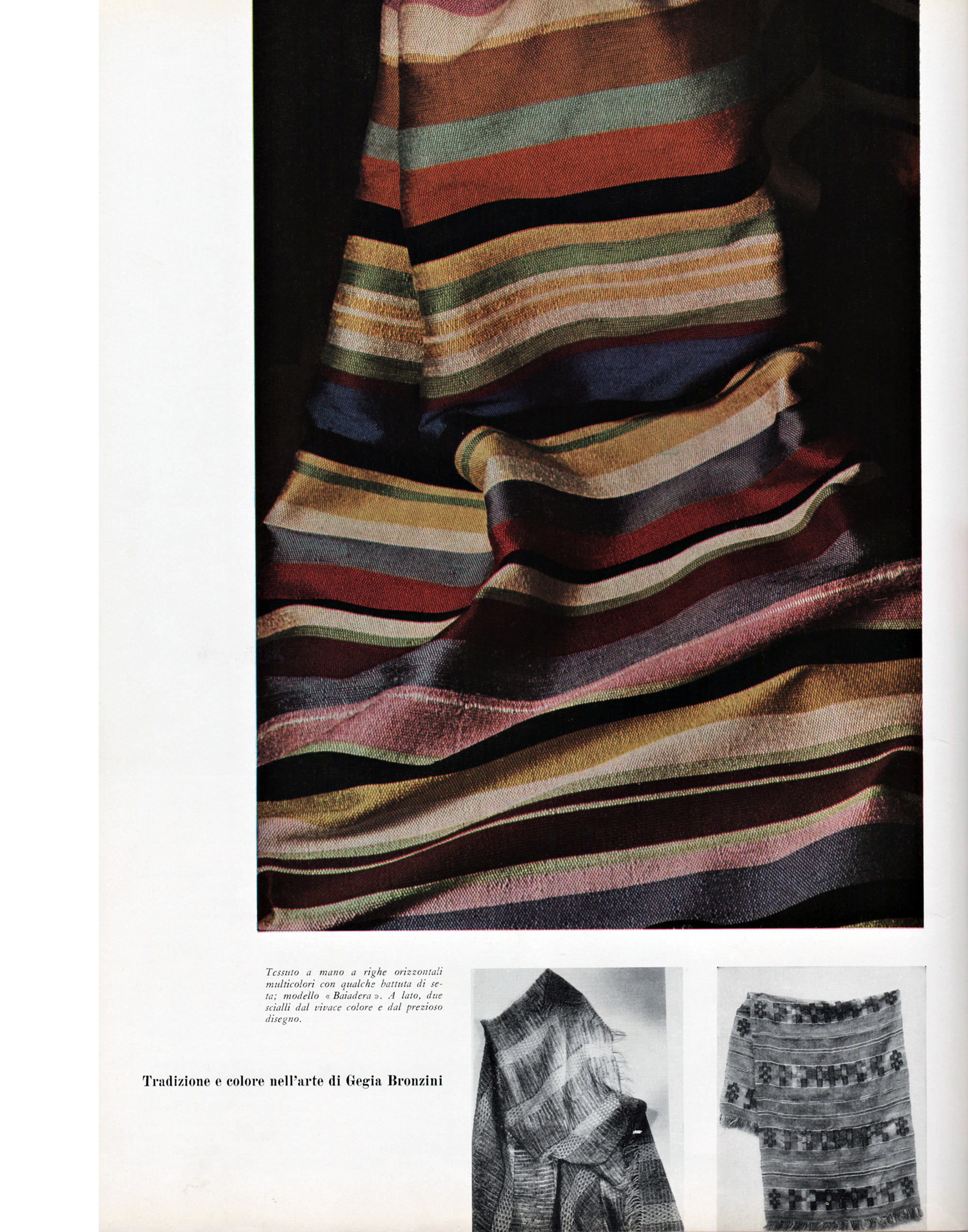
1963 - Artecasa, February 1963, n.41
1963 - Artecasa, February 1963, n.41
1963 - Artecasa, February 1963, n.41
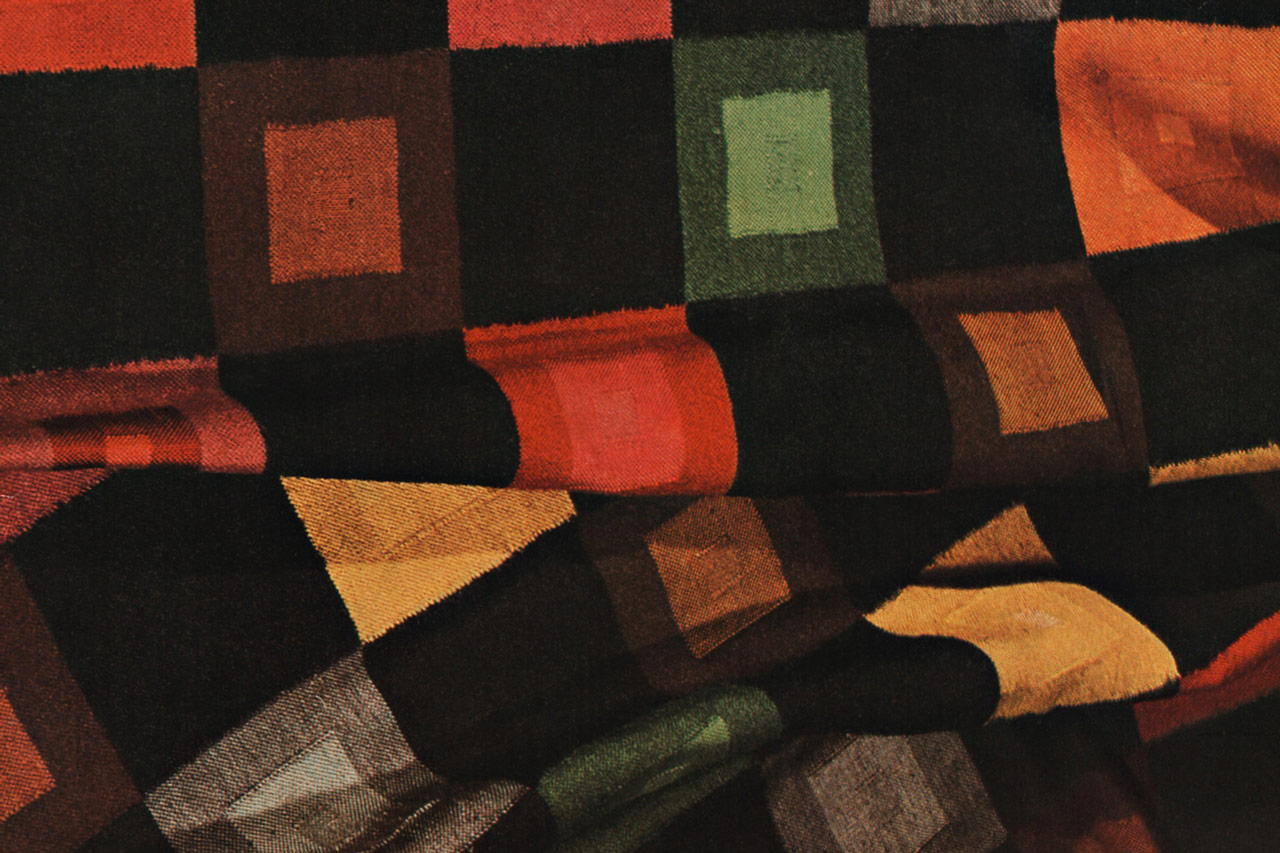

1955 Domus n. 304, March 1955
Only six: and it seems impossible that from those six "hand" looms come out thousands and thousands of meters of pure silk fabrics, one hundred and thirty centimetres wide, heavy, flexible, shiny, bright charming fabrics. "Thirty-five years ago (1929 ed), in the Veneto, I had seen a peasant woman weaving. It gave me a crazy desire to do the same; I asked my husband to buy me a loom. "What do you want to do with it?" He asked. "I want to weave," Gegia Bronzini answered firmly. So, from the very same peasant she learned the job of the weaver. But she did not limit herself to that: she began to create, combining colors, from heavy fabrics for upholstery to very light, transparent fabrics, for curtains. Each fabric can be said to have a name: Triennale, Parisi, Ermine. Gold, silver, all the ranges of violets, greens, grays, blues, pinks, all to witness to their magnificence. And of their extraordinary poetry. A poem that enters the scene with exhilaration and suddenly becomes painting, sculpture, music. Also music.
Carla Porta Musa
Taken from the magazine Como, winter 1964.
Only six: and it seems impossible that from those six "hand" looms come out thousands and thousands of meters of pure silk fabrics, one hundred and thirty centimetres wide, heavy, flexible, shiny, bright charming fabrics. "Thirty-five years ago (1929 ed), in the Veneto, I had seen a peasant woman weaving. It gave me a crazy desire to do the same; I asked my husband to buy me a loom. "What do you want to do with it?" He asked. "I want to weave," Gegia Bronzini answered firmly. So, from the very same peasant she learned the job of the weaver. But she did not limit herself to that: she began to create, combining colors, from heavy fabrics for upholstery to very light, transparent fabrics, for curtains. Each fabric can be said to have a name: Triennale, Parisi, Ermine. Gold, silver, all the ranges of violets, greens, grays, blues, pinks, all to witness to their magnificence. And of their extraordinary poetry. A poem that enters the scene with exhilaration and suddenly becomes painting, sculpture, music. Also music.
Carla Porta Musa
Taken from the magazine Como, winter 1964.
Only six: and it seems impossible that from those six "hand" looms come out thousands and thousands of meters of pure silk fabrics, one hundred and thirty centimetres wide, heavy, flexible, shiny, bright charming fabrics. "Thirty-five years ago (1929 ed), in the Veneto, I had seen a peasant woman weaving. It gave me a crazy desire to do the same; I asked my husband to buy me a loom. "What do you want to do with it?" He asked. "I want to weave," Gegia Bronzini answered firmly. So, from the very same peasant she learned the job of the weaver. But she did not limit herself to that: she began to create, combining colors, from heavy fabrics for upholstery to very light, transparent fabrics, for curtains. Each fabric can be said to have a name: Triennale, Parisi, Ermine. Gold, silver, all the ranges of violets, greens, grays, blues, pinks, all to witness to their magnificence. And of their extraordinary poetry. A poem that enters the scene with exhilaration and suddenly becomes painting, sculpture, music. Also music.
Carla Porta Musa
Taken from the magazine Como, winter 1964.
The 6 golden looms
of Gegia Bronzini
The 6 golden looms of Gegia Bronzini
The 6 golden looms of Gegia Bronzini
The 6 golden looms
of Gegia Bronzini
Only six: and it seems impossible that from those six "hand" looms come out thousands and thousands of meters of pure silk fabrics, one hundred and thirty centimetres wide, heavy, flexible, shiny, bright charming fabrics. "Thirty-five years ago (1929 ed), in the Veneto, I had seen a peasant woman weaving. It gave me a crazy desire to do the same; I asked my husband to buy me a loom. "What do you want to do with it?" He asked. "I want to weave," Gegia Bronzini answered firmly. So, from the very same peasant she learned the job of the weaver. But she did not limit herself to that: she began to create, combining colors, from heavy fabrics for upholstery to very light, transparent fabrics, for curtains. Each fabric can be said to have a name: Triennale, Parisi, Ermine. Gold, silver, all the ranges of violets, greens, grays, blues, pinks, all to witness to their magnificence. And of their extraordinary poetry. A poem that enters the scene with exhilaration and suddenly becomes painting, sculpture, music. Also music.
Carla Porta Musa
Taken from the magazine Como, winter 1964.
Only six: and it seems impossible that from those six "hand" looms come out thousands and thousands of meters of pure silk fabrics, one hundred and thirty centimetres wide, heavy, flexible, shiny, bright charming fabrics. "Thirty-five years ago (1929 ed), in the Veneto, I had seen a peasant woman weaving. It gave me a crazy desire to do the same; I asked my husband to buy me a loom. "What do you want to do with it?" He asked. "I want to weave," Gegia Bronzini answered firmly. So, from the very same peasant she learned the job of the weaver. But she did not limit herself to that: she began to create, combining colors, from heavy fabrics for upholstery to very light, transparent fabrics, for curtains. Each fabric can be said to have a name: Triennale, Parisi, Ermine. Gold, silver, all the ranges of violets, greens, grays, blues, pinks, all to witness to their magnificence. And of their extraordinary poetry. A poem that enters the scene with exhilaration and suddenly becomes painting, sculpture, music.
Also music.
Carla Porta Musa
Taken from the magazine Como, winter 1964.

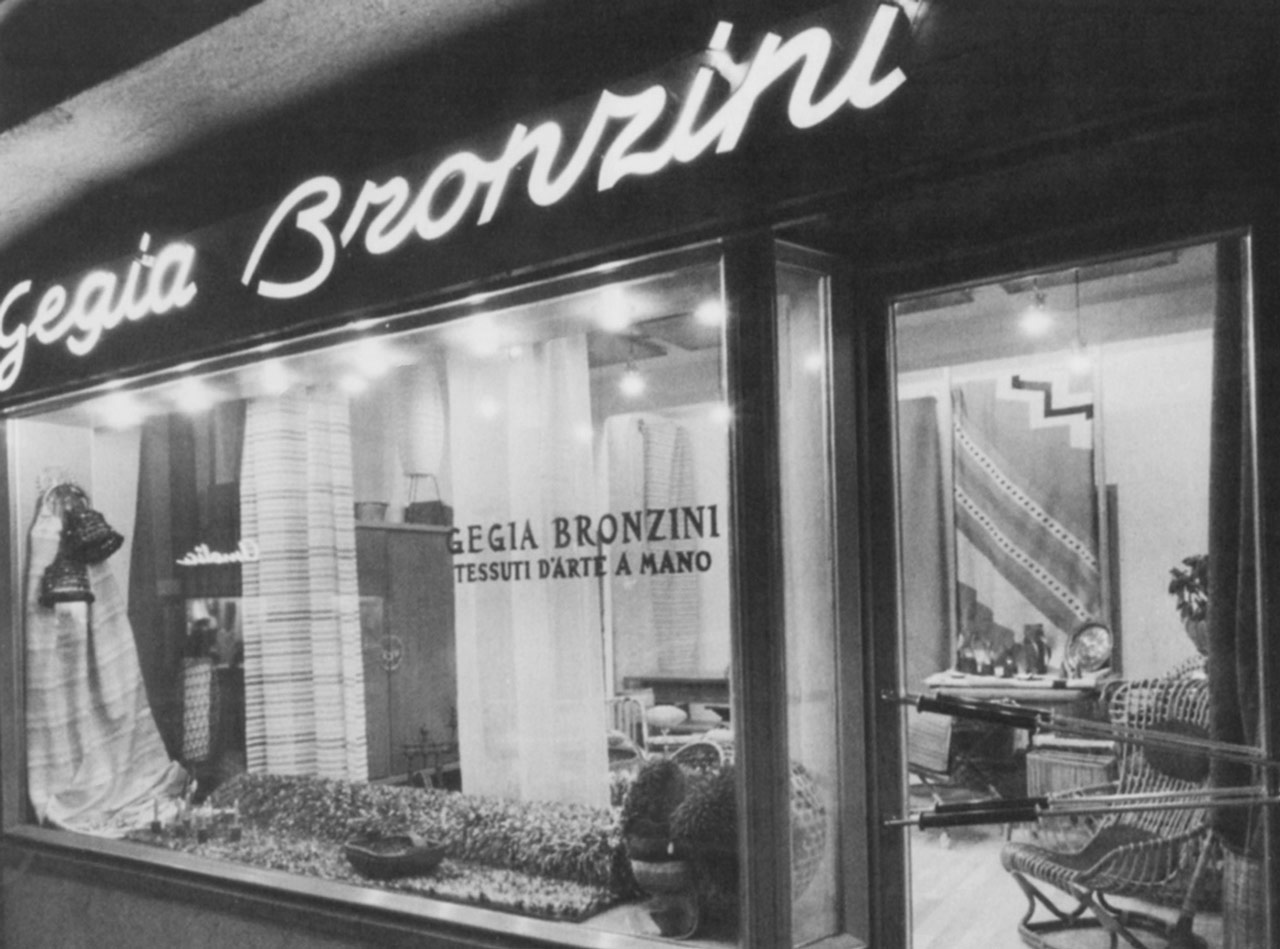
The stores
The success of the 1936 exhibition at the Loggetta del Sansovino, at the foot of the Campanile di San Marco, led the following year to the opening of the first store in Piazza San Marco. Antiqua Ars Nova was the name chosen to indicate a production based on an ancient technique re-actualized with the use of particular yarns, designs and types of contemporary products: to remain anchored to an ancient technique in order to create current products. (...) The enthusiasm, resourcefulness, creative sensitivity of Gegia (who was also the Director of the Rural Tissues of Venice) and Marisa Bronzini gave the opportunity to develop in an environment that was particularly sensitive to the complex of activities that revolve around the weaving. Even before the war broke out, the Milan store (1939, Galleria del Toro) was opened and immediately after the war the one in Cortina. The three stores (the one in Milan would be completely renewed at the end of the Sixties) and the sales point of Cantù remained active until the end of the Seventies. After Gegia's death, the activity was concentrated in Cantù, where Marisa dedicated herself to research on fabrics obtained with particular yarns and materials, supported by the most free creative experiences.
The stores
The success of the 1936 exhibition at the Loggetta del Sansovino, at the foot of the Campanile di San Marco, led the following year to the opening of the first store in Piazza San Marco. Antiqua Ars Nova was the name chosen to indicate a production based on an ancient technique re-actualized with the use of particular yarns, designs and types of contemporary products: to remain anchored to an ancient technique in order to create current products. (...) The enthusiasm, resourcefulness, creative sensitivity of Gegia (who was also the Director of the Rural Tissues of Venice) and Marisa Bronzini gave the opportunity to develop in an environment that was particularly sensitive to the complex of activities that revolve around the weaving. Even before the war broke out, the Milan store (1939, Galleria del Toro) was opened and immediately after the war the one in Cortina. The three stores (the one in Milan would be completely renewed at the end of the Sixties) and the sales point of Cantù remained active until the end of the Seventies. After Gegia's death, the activity was concentrated in Cantù, where Marisa dedicated herself to research on fabrics obtained with particular yarns and materials, supported by the most free creative experiences.
The stores
The success of the 1936 exhibition at the Loggetta del Sansovino, at the foot of the Campanile di San Marco, led the following year to the opening of the first store in Piazza San Marco. Antiqua Ars Nova was the name chosen to indicate a production based on an ancient technique re-actualized with the use of particular yarns, designs and types of contemporary products: to remain anchored to an ancient technique in order to create current products. (...) The enthusiasm, resourcefulness, creative sensitivity of Gegia (who was also the Director of the Rural Tissues of Venice) and Marisa Bronzini gave the opportunity to develop in an environment that was particularly sensitive to the complex of activities that revolve around the weaving. Even before the war broke out, the Milan store (1939, Galleria del Toro) was opened and immediately after the war the one in Cortina. The three stores (the one in Milan would be completely renewed at the end of the Sixties) and the sales point of Cantù remained active until the end of the Seventies. After Gegia's death, the activity was concentrated in Cantù, where Marisa dedicated herself to research on fabrics obtained with particular yarns and materials, supported by the most free creative experiences.
The stores
The success of the 1936 exhibition at the Loggetta del Sansovino, at the foot of the Campanile di San Marco, led the following year to the opening of the first store in Piazza San Marco. Antiqua Ars Nova was the name chosen to indicate a production based on an ancient technique re-actualized with the use of particular yarns, designs and types of contemporary products: to remain anchored to an ancient technique in order to create current products. (...) The enthusiasm, resourcefulness, creative sensitivity of Gegia (who was also the Director of the Rural Tissues of Venice) and Marisa Bronzini gave the opportunity to develop in an environment that was particularly sensitive to the complex of activities that revolve around the weaving. Even before the war broke out, the Milan store (1939, Galleria del Toro) was opened and immediately after the war the one in Cortina. The three stores (the one in Milan would be completely renewed at the end of the Sixties) and the sales point of Cantù remained active until the end of the Seventies. After Gegia's death, the activity was concentrated in Cantù, where Marisa dedicated herself to research on fabrics obtained with particular yarns and materials, supported by the most free creative experiences.
The stores
The success of the 1936 exhibition at the Loggetta del Sansovino, at the foot of the Campanile di San Marco, led the following year to the opening of the first store in Piazza San Marco. Antiqua Ars Nova was the name chosen to indicate a production based on an ancient technique re-actualized with the use of particular yarns, designs and types of contemporary products: to remain anchored to an ancient technique in order to create current products. (...) The enthusiasm, resourcefulness, creative sensitivity of Gegia (who was also the Director of the Rural Tissues of Venice) and Marisa Bronzini gave the opportunity to develop in an environment that was particularly sensitive to the complex of activities that revolve around the weaving. Even before the war broke out, the Milan store (1939, Galleria del Toro) was opened and immediately after the war the one in Cortina. The three stores (the one in Milan would be completely renewed at the end of the Sixties) and the sales point of Cantù remained active until the end of the Seventies. After Gegia's death, the activity was concentrated in Cantù, where Marisa dedicated herself to research on fabrics obtained with particular yarns and materials, supported by the most free creative experiences.
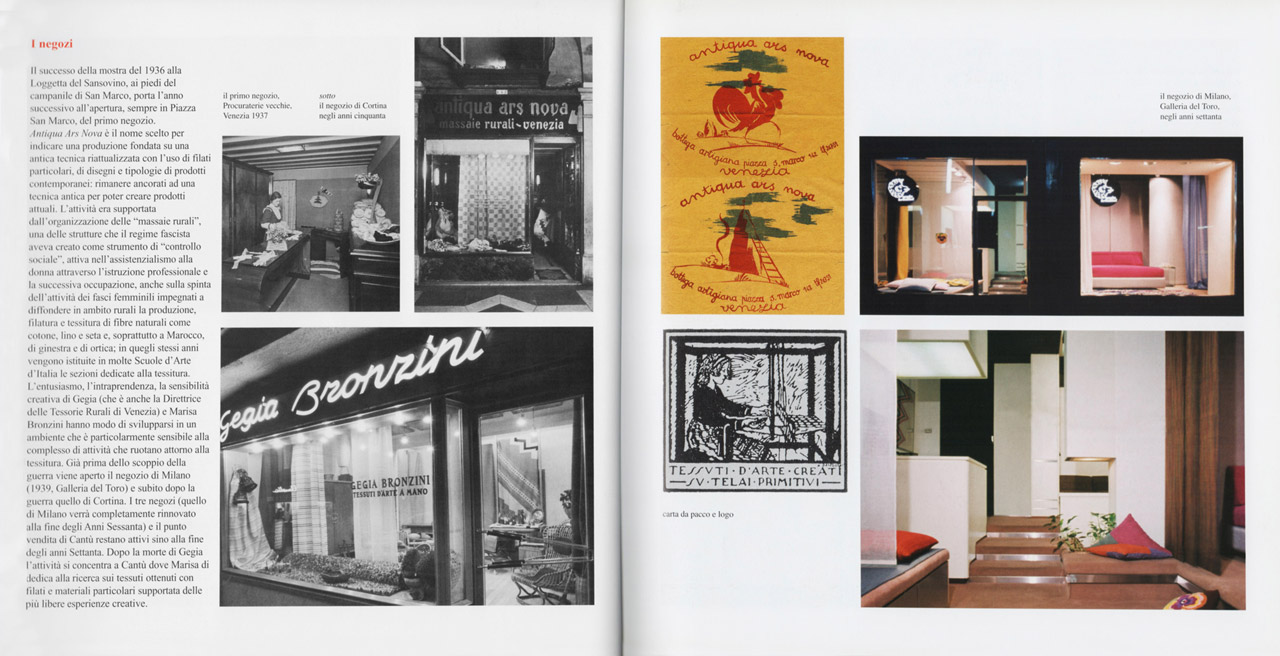

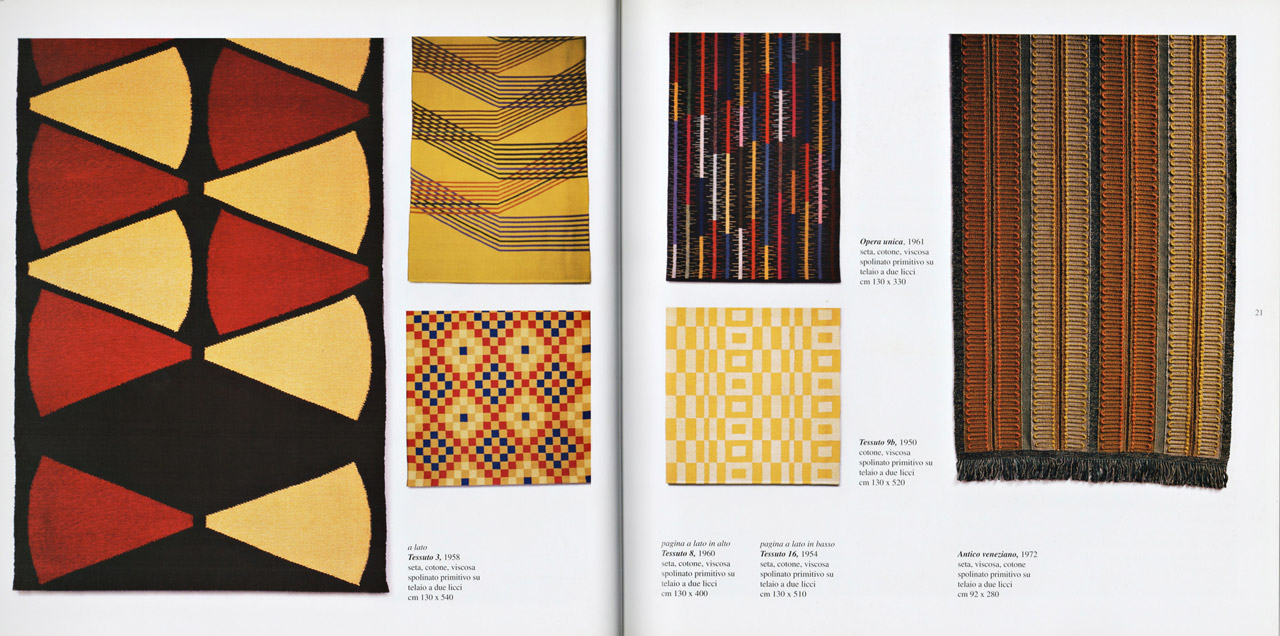
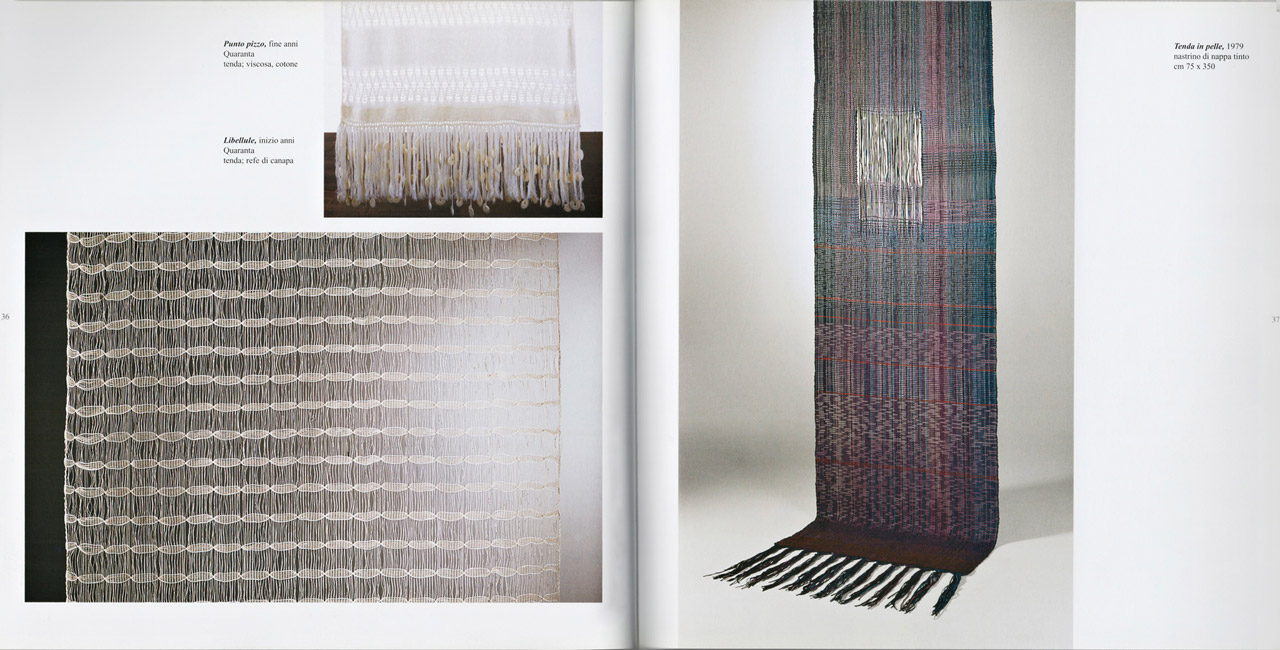
Gegia Bronzini Catalog Selection
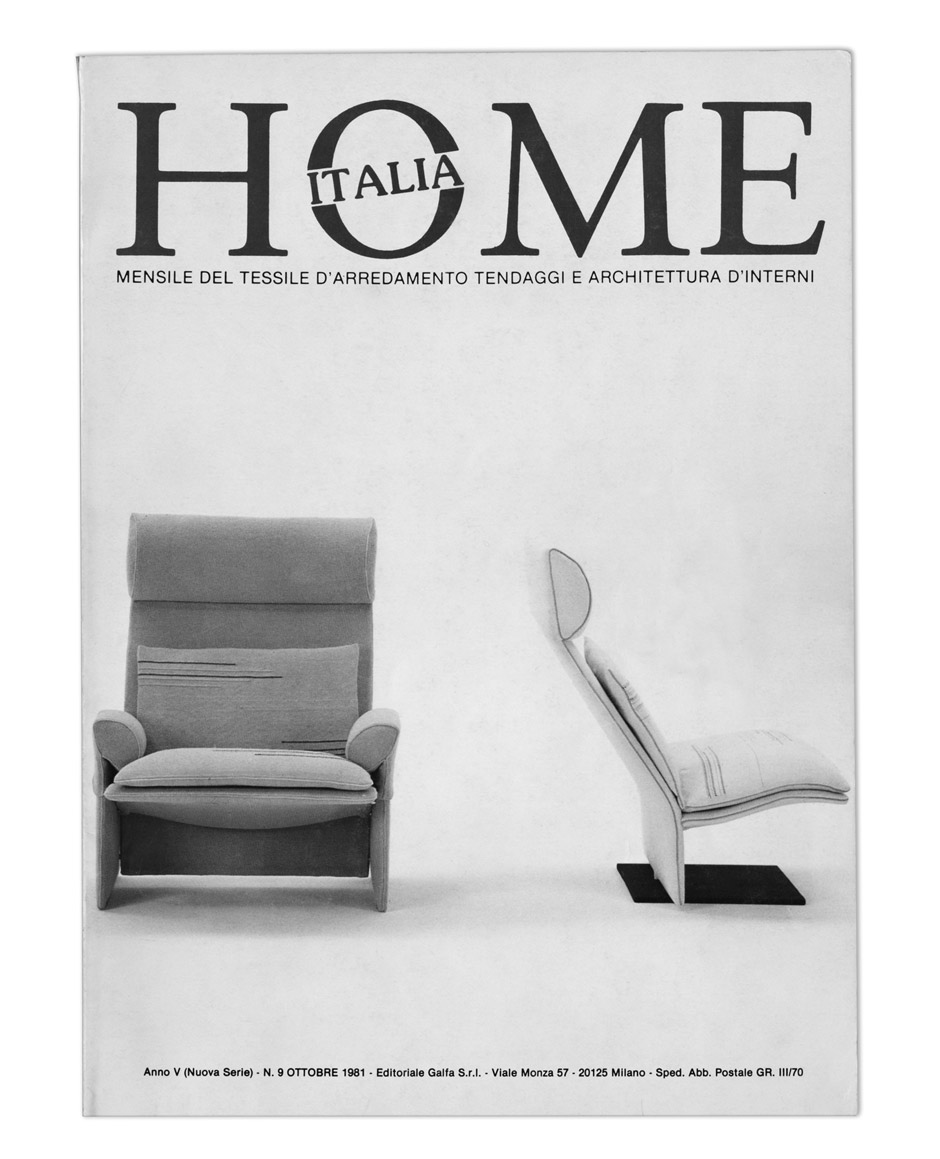
«Dream» bergère with or without armrests presented by Saporiti Italia at the latest Salone del Mobile, the fabrics are by Marisa Bronzini. The meeting between elegance of the structure and refinement of the fabric allows to underline the validity of the Italian proposal in furnishing. Cover of Home Italia, 1981 - Year V, n. 9 October 1981.
«Dream» bergère with or without armrests presented by Saporiti Italia at the latest Salone del Mobile, the fabrics are by Marisa Bronzini. The meeting between elegance of the structure and refinement of the fabric allows to underline the validity of the Italian proposal in furnishing. Cover of Home Italia, 1981 - Year V, n. 9 October 1981.
Gegia Bronzini
via Don Capiaghi 2/4
22070 Bregnano
Como, Italy
ph. +39 031 771631
fax +39 031 774892
Gegia Bronzini
via Don Capiaghi 2/4
22070 Bregnano
Como, Italy
ph. +39 031 771631
fax +39 031 774892
Gegia Bronzini
via Don Capiaghi 2/4
22070 Bregnano
Como, Italy
ph. +39 031 771631
fax +39 031 774892
Gegia Bronzini
via Don Capiaghi 2/4
22070 Bregnano
Como, Italy
ph. +39 031 771631
fax +39 031 774892
Copyright © 2020 TESSILE OFFICINA SRL - P. Iva 03879260135 - REA CO-403793 - Privacy Policy - Cookie Policy - Webdesign by Housegrafik
Copyright © 2020 TESSILE OFFICINA SRL - P. Iva 03879260135 - REA CO-403793
Privacy Policy - Cookie Policy - Webdesign by Housegrafik
Copyright © 2020 TESSILE OFFICINA SRL
P. Iva 03879260135 - REA CO-403793
Privacy Policy - Cookie Policy
